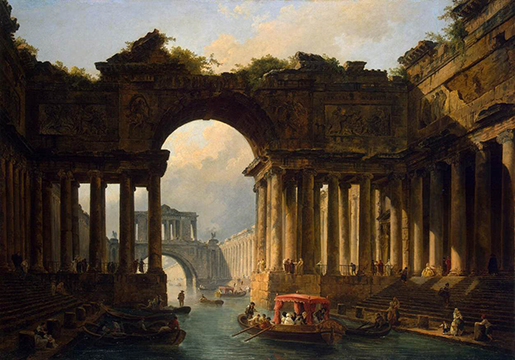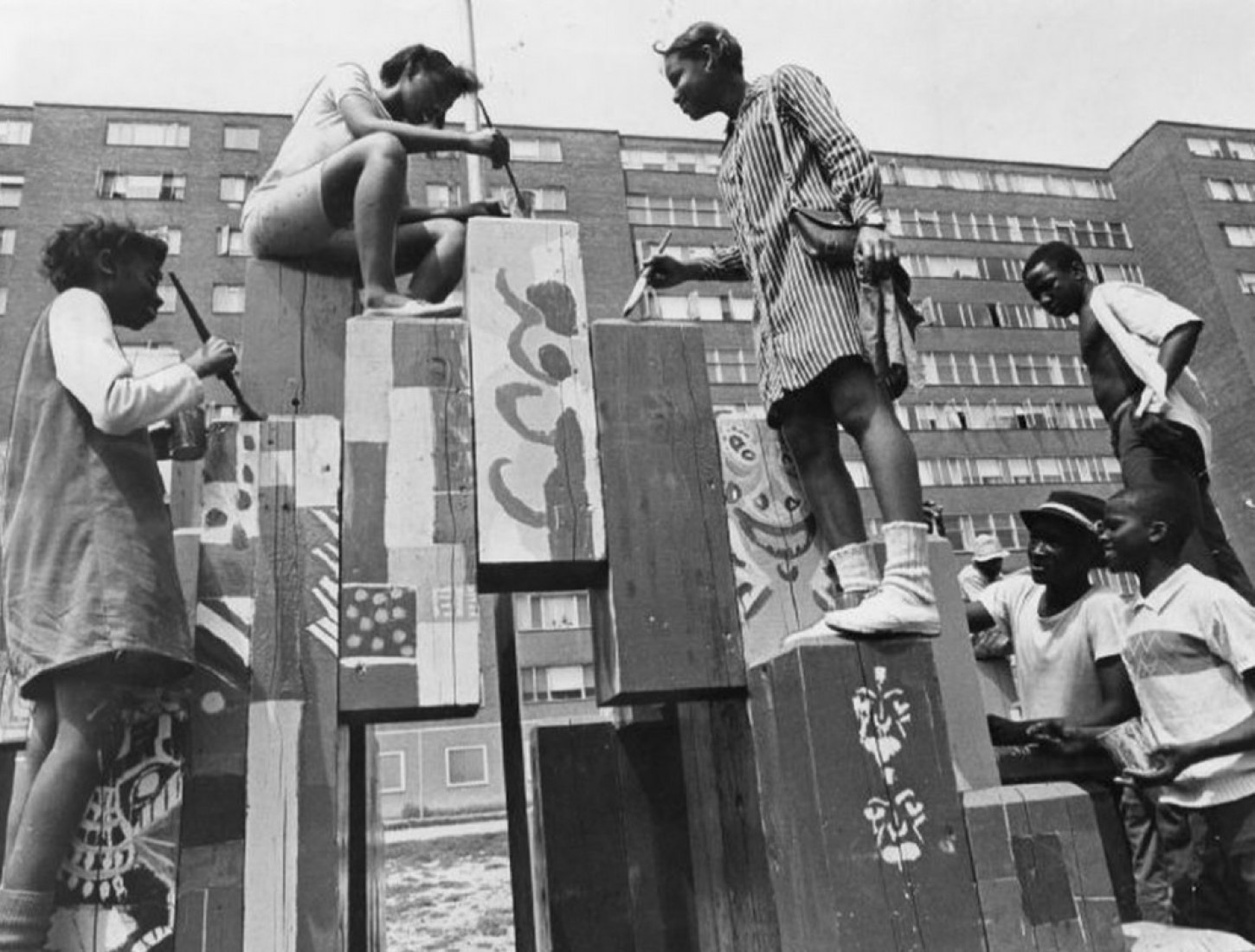Ruins are not only the reminder of an ideal past but also a representation of the natural death of architecture. Its importance was obvious during the Renaissance when the Greek-Roman ruins were seen with melancholy. Archaeological awareness was directed towards them; to the extent that its admiration generated a specific genre, the “painting of ruins”, as the ones made by G.B. Piranesi or Hubert Robert who found in them inspiration to create their work.

Roman Ruins. Giovanni Battista Piranesi.

“Architectural Landscape with a Canal”. Hubert Robert, 1783.
Ruins were an invitation to the reproduction of the present, still; they were essentially a symbol of the fading of human companies. Nevertheless, this slow and sorrowful degradation doesn’t seem to obey to cultural dynamics of modern times. Our contemporary world grants privilege to sudden and violent destruction. Twentieth century wars based upon a sustained model of aggressive destruction devastated entire settlements, which later produced essential changes in architecture and urbanism.
In the early 21st century we all witnessed the attack to the Twin Towers. This episode caused on people worldwide further emotional impact than any other architectonic destruction and reminded us, altogether, of Sodom and Gomorrah fire and sulfur, the flames or rays that according to old stories demolished Babel Tower, the hell-like volcano structures imagined by “El Bosco” and Guernica´s absurd attack.(2) Absolutely unhopeful, the 21st century comes hand in hand with real ecological threats and wars.

Bombing of Guernica. Spanish civil war. 1937.
Some decades ago, such persistent apocalyptic thinking could be observed in the documentary film Kooyaanisqatsi.(3) Its director, Godfrey Reggio, would produce the film over a period of time in which postmodernism over modernism was a matter of serious debate. Koyaanisqatsi, with his clear moral position on the state of the culture of great cities, and with an implied semiotic message on postmodern issues, leaves us a controversial episode of the documentary to debate upon: the demolition of Pruitt-Igoe,(4) which the audience watches as omniscient spectators to the spectacle.
After two decades of not only severe socioeconomic problems, but also ethnic and genre related issues Pruitt-Igoe failed along with the unsuccessful housing policies from its generation. Hardly any images in the history of architecture are as impressive as the ones from its demolition in 1972. Pruitt-Igoe, both architectonic icon and myth,(5) is not only the metaphor of the Apocalypse of Koyaanisqatsi but also the profound fascination to the image itself, as it is the architectonic outburst, the remains in the very moment of their creation.

“Pruitt-Igoe” project by Minoru Yamasaki demolished between 1972 y 1975. Source: St. Louis Post Dispatch.
Pruitt-Igoe suggested an underlying victory of postmodernism over modernism, and its speech came along with memory as the main point of debate of postmodern thinking. It was about the memory embedded in the nostalgic feelings of ancient ruins.
This debate takes place inside of a context in which the willingness of feeling fulfilled through the media, of being “immortal” becomes compulsive behavior.
In 1980 a group of artists called Teilbereich Kunst, made reference to Herostratus in their exhibition. Sentenced to death 2000 years ago (365 bC), after burning the temple of Artemisa in Ephesos, Herostratus committed such atrocity with the unique aim of ensuring his place in history. Heinz Schutz compares Herostratus with Pruitt-Igoe: Ruins equals Fame . They both were condemned to forgetfulness; nonetheless, they undeniably became part of History.

“Pruitt-Igoe” 1968. Children painting the game area as part of a school project. Source: St. Louis Post Dispatch.
Architectonic and urban destruction has been brought about by different factors or causes such as natural disasters, wars, or deliberate demolitions. Historical references on violent towns and cities destruction are largely widespread. But what is fundamental, though abruptly evident, is that such fatal and undesirable destructions have found their place in our cultural minds and many of them have become the origins of promising episodes of progress.
Constructions and human companies are far more frail than they seem; vast towns and great monuments have been vulnerable of being deafened, and their image is completely distant, for instance those romantic paintings by Hubert Robert. The physical and psychological traces and the devastating landscape of these contemporary ruins do not represent, as in ancient Rome, the incommensurable greatness of their culture. In contrast, they represent the weakness of current population, of our globalised world facing nature and human existence itself.
On the other hand, even if that feeling of melancholy of ruins worn away by time no longer exists, and there is merely the memory of wreckage embodied in a virtual and persistent image of the media, it is relevant to talk about destruction, pain, emptiness; to be able to approach its inevitable face: CONSTRUCTION, that (re)construction that is inevitably made through MEMORY.

"Guernica”. Pablo Picasso. 1937.

“Koyaanisqatsi”. Soundtrack cover.
---
(1) SERLIO, Sebastiano. “I sette libri dell’ archittetura”. In: RAMÍREZ, Juan Antonio. “De la ruina al polvo. Historia sucinta de la destrucción arquitectónica”. In “Arquitectura Viva”. No. 79-80. Year 2001. Pg. 100.
(2) RAMÍREZ, Juan Antonio. Op. cit (1) Pgs. 100-105.
(3) Social housing project by the architect Minoru Yamasaki, located in St. Louis, Missouri, whose construction was finished in 1954.
(4) BRISTOL, Katharine. “The Pruitt-Igoe myth”. In “EGGENER, Keith. “American architectural history: a contemporary reader”. Ed. Routledge. New York. 2004. Pgs. 352-364.
(5) SCHUTZ, Heinz. “Fame + Ruins”. En “Architectural Design”. No. 154. Pgs. 54-57. November 2001.
¡¡MONDAY MORE!! > "NEXT MONDAY, THIRD ADVANCE FOR NEXT SEASON: MICHAEL MORADIELLOS"
IN TREATMENT - METALOCUS.
DIRECTOR: JOSÉ JUAN BARBA. COORDINATION: INÉS LALUETA. ORGANIZATION: INÉS LALUETA, PEDRO NAVARRO. ENGLISH VERSION: KAREN SIMPSON. GUESTS FIRST SEASON: JOSÉ JUAN BARBA, MARINA DIEZ-CASCÓN, SERGIO DIEZ-CASCÓN SOLER, LARA FERNÁNDEZ GONZÁLEZ, CARLOS GERHARD PI-SUÑER, MONTSE PLA GARCÍA-CASTANY, XAVIER NICOLAU CUYÀS, FERNANDO RIAL PONCE, VERÓNICA ROSERO.






















